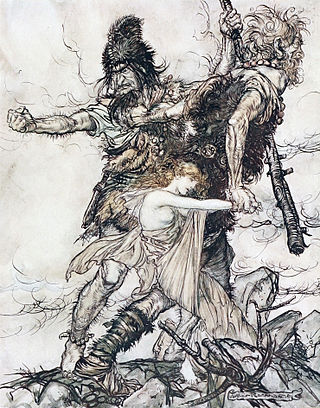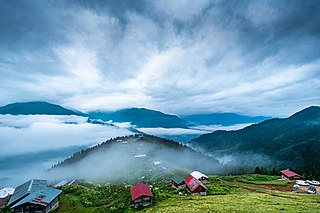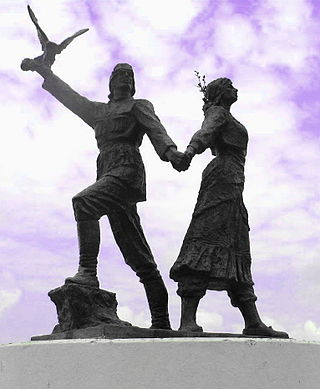Related Research Articles

A dragon is a magical legendary creature that appears in the folklore of multiple cultures worldwide. Beliefs about dragons vary considerably through regions, but dragons in Western cultures since the High Middle Ages have often been depicted as winged, horned, and capable of breathing fire. Dragons in eastern cultures are usually depicted as wingless, four-legged, serpentine creatures with above-average intelligence. Commonalities between dragons' traits are often a hybridization of feline, reptilian, mammalian, and avian features. Some scholars believe large extinct or migrating crocodiles bear the closest resemblance, especially when encountered in forested or swampy areas, and are most likely the template of modern Asian dragon imagery.

In folklore, giants are beings of humanoid appearance, but are at times prodigious in size and strength or bear an otherwise notable appearance. The word giant is first attested in 1297 from Robert of Gloucester's chronicle. It is derived from the Gigantes of Greek mythology.
Mbuti (Bambuti) mythology is the mythology of the African Mbuti Pygmies of Congo.

A nian beast is a beast in Chinese mythology. According to Chinese mythology, the nian lives under the sea or in the mountains. The Chinese character nian more usually means "year" or "new year". The earliest written sources that refer to the nian as a creature date to the early 20th century. As a result, it is unclear whether the nian creature is an authentic part of traditional folk mythology, or a part of a local oral tradition that was recorded in the early 20th century. Nian is one of the key characters in the Chinese New Year. Scholars cite it as the reason behind several practices during the celebration, such as wearing red clothing and creating noise from drums and fireworks.
A haltija (haltia) is a spirit, gnome, or elf-like creature in Finnish mythology that guards, helps, or protects something or somebody. The word is possibly derived from the Gothic haltijar, which referred to the original settler of a homestead—although this is not the only possible etymology. It can also be derived from the Finnish verb hallita, which means 'to rule', 'to command', 'to master'.

Rize Province is a province of northeast Turkey, on the eastern Black Sea coast between Trabzon and Artvin. The province of Erzurum is to the south. Its area is 3,835 km2, and its population is 344,016 (2022). The capital is the city of Rize. It was formerly known as Lazistan, however the designation of the term of Lazistan was officially banned in 1926.
Georgian mythology refers to the mythology of pre-Christian Georgians, an indigenous Caucasian ethnic group native to Georgia and the South Caucasus. The mythology of the Kartvelian peoples is believed by many scholars to have formed part of the religions of the kingdoms of Diauehi, Colchis and Iberia.

Artvin Province is a province in Turkey, on the Black Sea coast in the northeastern corner of the country, on the border with Georgia. Artvin also borders the Turkish provinces of Erzurum, Ardahan and Rize. Its area is 7,393 km2, and its population is 169,403 (2022). The provincial capital is the city of Artvin.

Çamlıhemşin, formerly Vice, is a small town in Rize Province in the Black Sea region of Turkey. It is the seat of Çamlıhemşin District. Its population is 1,763 (2021).

Çayeli is a town in Rize Province on the Black Sea coast of eastern Turkey, 18 km east of the city of Rize. It is the seat of Çayeli District. Its population is 24,583 (2021).

Arhavi is a town in Artvin Province located in the Black Sea Region of Turkey. It is the seat of Arhavi District. Its population is 17,558 (2022), making it the third most populous municipality in Artvin Province. Laz people form a large portion of the population. The terrain is hilly and mountainous. Area of the city center is about 6 km2 (2.3 sq mi). The length of the coast is about 10 km (6.2 mi). Arhavi is famous by the Culture and Art Festival that celebrated since 1973.

Brazilian mythology is the subset of Brazilian folklore with cultural elements of diverse origin found in Brazil, comprising folk tales, traditions, characters and beliefs regarding places, people, and entities. The category was originally restricted to indigenous elements, but has been extended to include:

The Laz people, or Lazi, are a Kartvelian ethnic group native to the South Caucasus, who mainly live in Black Sea coastal regions of Turkey and Georgia. They traditionally speak the Laz language but have experienced a rapid language shift to Turkish.
The Lozi people believed in a creator god, whom the Lozi call Nyambe. Nyambe's wife was Nasilele and his mother was Ngula. Nyambe is said to have created both his wife and his mother. He is also said to have created everything else that exists, including the heaven, the Earth and all the plants and animals.

Melanesian mythology refers to the folklore, myths, and religions of Melanesia, a region in Southwest Oceania that encompasses the archipelagos of New Guinea, the Torres Strait Islands, Solomon Islands, Vanuatu, New Caledonia and Fiji. The various mythologies consist primarily of the traditions of oral literature in the different populations of Melanesia. More recent aspects include the cargo cults born in the 20th century during the Pacific War.
Mythic humanoids are legendary, folkloric, or mythological creatures that are part human, or that resemble humans through appearance or character. Each culture has different mythical creatures that come from many different origins, and many of these creatures are humanoids. They are often able to talk and in many stories they guide the hero on their journey.

Inca mythology is the universe of legends and collective memory of the Inca civilization, which took place in the current territories of Colombia, Ecuador, Peru, Bolivia, Chile, and Argentina, incorporating in the first instance, systematically, the territories of the central highlands of Peru to the north.
References
- ↑ Ascherson (2015). Black Sea: The Birthplace of Civilisation and Barbarism. Random House. p. 184. ISBN 978-1784700911 . Retrieved 20 December 2019.
- ↑ Özhan Öztürk. Karadeniz Ansiklopedik Sözlük. 2005. İstanbul. ss. 417-18